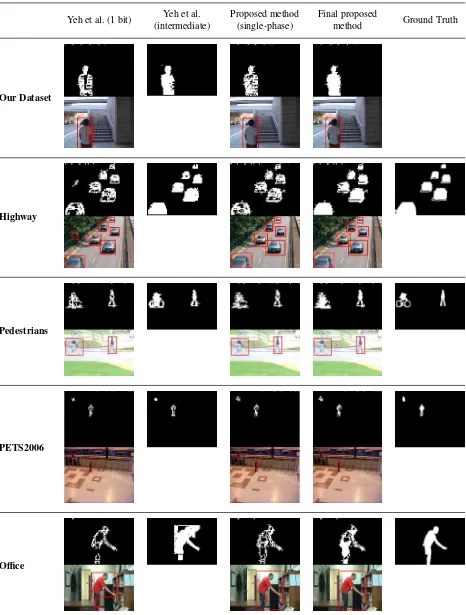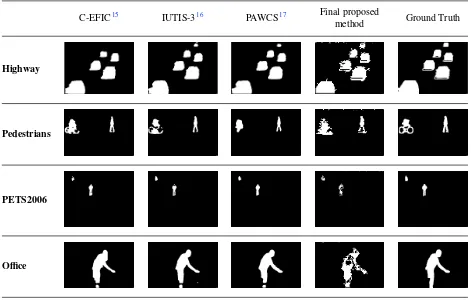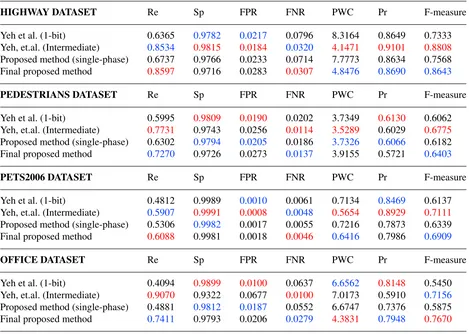ScienceDirect
Procedia Computer Science 135 (2018) 579–586
1877-0509 © 2018 The Authors. Published by Elsevier Ltd.
This is an open access article under the CC BY-NC-ND license (https://creativecommons.org/licenses/by-nc-nd/4.0/)
Selection and peer-review under responsibility of the 3rd International Conference on Computer Science and Computational Intelligence 2018.
10.1016/j.procs.2018.08.228
© 2018 The Authors. Published by Elsevier Ltd.
This is an open access article under the CC BY-NC-ND license (https://creativecommons.org/licenses/by-nc-nd/4.0/)
Selection and peer-review under responsibility of the 3rd International Conference on Computer Science and Computational Intelligence 2018.
Keywords: change detection; foreground segmentation; texture features.
1. Introduction
Moving object detection is an underlying task in computer vision field, especially for extracting the insights from the video surveillance footages. This technology is often implemented to a higher-level vision, such as the human ges-ture and gait recognition, vehicle counting, and intelligent robot vision. Recently, the object recognition technology, which is able to improve the safety of outdoor activities (e.g., vehicle, pedestrian, etc.), has been massively deployed on the Smart City solution in developing countries. Some kinds of literature have been comprehensively reviewed the
∗Corresponding author.
E-mail address:[email protected]
3rd International Conference on Computer Science and Computational Intelligence 2018
An Improved Version of Texture-based Foreground Segmentation:
Block-based Adaptive Segmenter
Kahlil Muchtar
a,b,∗, Faris Rahman
a, Tjeng Wawan Cenggoro
c,e, Arif Budiarto
c,e, Bens
Pardamean
d,eaNodeflux, Inc., Jakarta, Indonesia bSyiah Kuala University, Aceh, Indonesia
cComputer Science Department, School of Computer Science, Bina Nusantara University, Jakarta, Indonesia 11480
dComputer Science Department, BINUS Graduate Program - Master of Computer Science Program, Bina Nusantara University, Jakarta,
Indonesia 11480
eBioinformatics and Data Science Research Center, Bina Nusantara University, Jakarta, Indonesia 11480
Abstract
ing on pixel intensities, we use texture information and model the observed block by incorporating the neighbourhood information. As thoroughly evaluated in the experimental section, the proposed idea greatly reduces the complexity, and keep the speed of real-time applications.
In section2, we review several related works. Then, in section3, we thoroughly discuss our proposed method. The qualitative and quantitative measurements are provided in section4. Eventually, we draw the conclusions in section5.
2. Related work
Typically, the techniques used for background (BG) model are based on the technique developed by Stauffer and Grimson3that uses Mixture of Gaussians (GMM) model1,4. The idea of GMM-based BG model is that the distribution of pixel value over time can be modeled by using mixture of Gaussian models. There has been several researches used technique based on Stauffer and Grimson technique5,6,7,8,9.
Albeit the popularity of GMM-based BG model, texture-based BG model shows a better promise for real appli-cations. Texture-based BG model has been known to be able to maintain its robustness in environments with the variation of illumination and shadows1,10,11, thus it generally performs better in case of real application. Local binary pattern (LBP) is typically used as the texture feature in order to build the BG model11,12,13,14. However, the method that was originally proposed by Heikkila, et al.11is inappropriate for real-time application. Instead of using overlap-ping block, in 2014, Yeh et al.10 introduced a non-overlapping block idea which is significantly faster compared to previous texture-based methods.
3. Proposed Method
We separate this section into three subsections: base model, Pixel-Based Adaptive Segmenter (PBAS), and Block-Based Adaptive Segmenter (BBAS) respectively. BBAS is our proposed method that infuse the idea from PBAS into the base model.
3.1. Base Model
Our proposed model is based on the model proposed by Yeh et al.10which uses a non-overlapping block to subtract the background. The initial step is to divide the current frame into n x n non-overlapping blocks. It is typically set the n to 4, in most of the experiments. Finally, the process converts each block into a binary bitmap according to Eq.1,
bi j=
0,i f Xi j <mean+T H,
1,otherwise. (1)
where mean is the mean of a block,Xi,jis the pixel value at (i,j), andT His the pre-defined threshold according to the human visual system (HSV). Fig.1illustrates the process for bitmap generation of one 3 x 3 block.
When a new bitmap, BMobserved, comes in, it will be compared against the several number of weights BG model
BMmodel, where the total number of weights is set as parameterK in the algorithm. Afterwards, the similarity be-tween BMobservedand BMmodel is calculated through Hamming distance (as shown in Eq.2). If the distance between
BMobservedand BMmodelexceeds the predefined threshold, the block is classified as foreground (FG), and vice versa.
Note that, none of spatio-temporal information is involved in this method.
Dist(BMobserved,BMmodel)=
Fig. 1: Example of bitmap conversion. Fig. 2: Example of block transition.
3.2. Pixel-Based Adaptive Segmenter
The proposed method in this paper incorporates the idea of the pixel-based adaptive segmenter (PBAS)2into the base model. PBAS builds the model using the several initialNframes. Then, it calculates the distance of each pixel on a recent frame and previous N frames. The accumulation of distance willinfluence the threshold whether getting higher or lower adaptively. Furthermore, if the observed pixel is regarded as BG, then the random neighbourhood pixels are also updated. This model is slow to update and may not be appropriate for several cases of online applications.
3.3. Block-based Adaptive Segmenter (BBAS)
3.3.1. Single-phase improvement
Our first improvement is to modify the update scheme of Yeh, et.al.s method10. Compared to this method which
only updates the corresponding BG model of the observed block, our proposed idea also incorporates the adjacent
blocks by prior checking the similarity and update the adjacent BG models, accordingly. More specifically, different
from2that select and update randomly neighboring pixels, we first check the similarity of the observed BM
modelwith BMad jacent model via hamming distance. If the similarity of models exceeds theT Had jacent, then allBMad jacent modelis
replaced by its current binary bitmap. In this research, theT HandT Had jacentare set to 8 and 13, respectively.
The benefit of using BBAS is that the fragment issues (in the inner region of a detected object) can be alleviated.
This benefit can be seen by comparing the qualitative results of our dataset shown in table1. Moreover, uninteresting
foreground region can also be corrected and regarded as BG region, as seen in qualitative results of highway dataset in table1.
3.3.2. Final improvement
In Yeh, et.al.10, the bit transition is calculated to determine the mode of a block. If the block is complex, then
the higher level is employed (2 or 3-bits mode, instead of 1-bit mode). In our proposed scheme, the result from the first phase allows further improvement by utilizing bit transition in order to check the complexity of observed block
and adjacent blocks. The Fig.2shows an example of accumulating bit transition of a block. Note that, higher total
transition, more complex block and texture information will be.
If the observed block is classified as BG, we then check the complexity of current adjacent blocks and whether it
is FG block or not. As shown in Eq.3, if both conditions are satisfied (the adjacent blocks are all complex and FG
blocks), then we replace the label of the observed block from BG to FG. As shown in the qualitative results of final
proposed method in table1, our final contribution can correct the mislabel blocks inside the detected objects.
Replace(BMobserved)=
BMoutput=FG,if (BMcomplexandBMoutput adjacent FG=true) BMoutput=BG,else
(3)
4. Experimental Results
We provide the comprehensive evaluation including qualitative and quantitative measurements. In this research,
we use our own dataset and CDNet dataset18. Our own dataset shows a person moving slowly towards the stairs. Our
Our Dataset
Highway
Pedestrians
PETS2006
Table 2: Qualitative results of other methods compared to final proposed method.
C-EFIC15 IUTIS-316 PAWCS17 Final proposed
method Ground Truth
Highway
Pedestrians
PETS2006
Office
method is competitive to the previous method on CDNET201418challenges. Here we tested 4 videos from baseline category. Note that, we only use CPU-based processing, that is suitable for thin client.
It is worth mentioning that one of the main objectives of our proposed method is to offer a robust and more efficient approach compared to Yeh et al. method and also several state-of-the-arts methods. Therefore, in order to benchmark the proposed method, we consider Yeh et al.’s method and three state-of-the-art and spatial/ temporal-based methods which were developed in the past three years: C-EFIC15, IUTIS-316, and PAWCS17. The first method, C-EFIC, models BG by using a combination of edge descriptor and color information in spatio-temporal domain. Meanwhile, IUTIS-3 combines several state-of-the-art methods of BG model by using genetic programming. The last method, PAWCS, introduced a concept of background words for background modelling. Background words can conceptually be explained as the color and texture characteristic of pixels over time.
4.1. Qualitative Measurements
4.1.1. Our own and CDNET 2014 dataset
CDNET is a benchmark of real-world scenes that was first introduced for the 2012 CVPR Workshop Change De-tection. It offers a specific and challenging segmentation problem. In our experiments, we select the baseline scenarios that contain four problems namely highway, pedestrians, PETS2006, and office. Note that, the corresponding ground truth images are provided by the dataset.
4.2. Quantitative Measurements
Yeh, et.al. (Intermediate) 0.8534 0.9815 0.0184 0.0320 4.1471 0.9101 0.8808 Proposed method (single-phase) 0.6737 0.9766 0.0233 0.0714 7.7773 0.8634 0.7568 Final proposed method 0.8597 0.9716 0.0283 0.0307 4.8476 0.8690 0.8643
PEDESTRIANS DATASET Re Sp FPR FNR PWC Pr F-measure
Yeh et al. (1-bit) 0.5995 0.9809 0.0190 0.0202 3.7349 0.6130 0.6062 Yeh, et.al. (Intermediate) 0.7731 0.9743 0.0256 0.0114 3.5289 0.6029 0.6775 Proposed method (single-phase) 0.6302 0.9794 0.0205 0.0186 3.7326 0.6066 0.6182 Final proposed method 0.7270 0.9726 0.0273 0.0137 3.9155 0.5721 0.6403
PETS2006 DATASET Re Sp FPR FNR PWC Pr F-measure
Yeh et al. (1-bit) 0.4812 0.9989 0.0010 0.0061 0.7134 0.8469 0.6137 Yeh, et.al. (Intermediate) 0.5907 0.9991 0.0008 0.0048 0.5654 0.8929 0.7111 Proposed method (single-phase) 0.5306 0.9982 0.0017 0.0055 0.7216 0.7873 0.6339 Final proposed method 0.6088 0.9981 0.0018 0.0046 0.6416 0.7986 0.6909
OFFICE DATASET Re Sp FPR FNR PWC Pr F-measure
Yeh et al. (1-bit) 0.4094 0.9899 0.0100 0.0637 6.6562 0.8148 0.5450 Yeh, et.al. (Intermediate) 0.9070 0.9322 0.0677 0.0100 7.0173 0.5910 0.7156 Proposed method (single-phase) 0.4881 0.9812 0.0187 0.0552 6.6747 0.7376 0.5875 Final proposed method 0.7411 0.9793 0.0206 0.0279 4.3831 0.7948 0.7670
false positive rate (FPR), false negative rate (FNR), percentage of wrong classification (PWC), precision, and F-measure.
As shown in table3and5, the final proposed method can outperform 1-bit mode of Yeh et al.s method and still competitive to Yeh et al. intermediate method. Note that, red and blue colour indicate the best and the second-best score, respectively. From table4, we can see that the performance of other state-of-the-art methods are generally better than our method. However, based on table6and7, we can see that our final proposed algorithm generally has a greater FPS improvement percentage than performance declining compared to others. Bold number in those two tables means that the corresponding FPS improvement percentage in table5is greater than the performance declining (negative of the value in table6and7).
Table 4: Average measurements of on baseline category.
Re Sp FPR FNR PWC Pr F-measure
C-EFIC15 0.8212 0.9934 0.0065 0.0162 1.9930 0.9124 0.8625
IUTIS-316 0.8538 0.9962 0.0037 0.0116 1.3419 0.9532 0.8999
PAWCS17 0.8017 0.9966 0.0033 0.0153 1.6352 0.9537 0.8676
Table 5: Comparison of FPS and final proposed method FPS improvement percentage.
Yeh et al. Yeh et al.
C-EFIC15 IUTIS-316 PAWCS17 Proposed method
(1-bit) (intermediate) Single-Phase Final
FPS 64 39.17 16 10 27 46.23 43.69
Improvement -31.73% 11.54% 173.06% 336.90% 61.81% -5.49%
-Table 6: Improvement percentage of final proposed method.
HIGHWAY DATASET Re Sp FPR FNR PWC Pr F-measure
Yeh et al. (1-bit) 35.07% -0.67% -30.41% 61.43% 41.71% 0.47% 17.86% Yeh, et.al. (Intermediate) 0.74% -1.01% -53.80% 4.06% -16.89% -4.52% -1.87% Proposed method (single-phase) 27.61% -0.51% -21.46% 57.00% 37.67% 0.65% 14.20%
PEDESTRIANS DATASET Re Sp FPR FNR PWC Pr F-measure
Yeh et al. (1-bit) 21.27% -0.85% -43.68% 31.85% -4.84% -6.67% 5.63% Yeh, et.al. (Intermediate) -5.96% -0.17% -6.64% -20.32% -10.96% -5.11% -5.49% Proposed method (single-phase) 15.36% -0.69% -33.17% 26.21% -4.90% -5.69% 3.57%
PETS2006 DATASET Re Sp FPR FNR PWC Pr F-measure
Yeh et al. (1-bit) 26.52% -0.08% -80.00% 24.59% 10.06% -5.70% 12.58% Yeh, et.al. (Intermediate) 3.06% -0.10% -125.00% 4.17% -13.48% -10.56% -2.84% Proposed method (single-phase) 14.74% -0.01% -5.88% 16.36% 11.09% 1.44% 8.99%
OFFICE DATASET Re Sp FPR FNR PWC Pr F-measure
Yeh et al. (1-bit) 81.02% -1.07% -106.00% 56.20% 34.15% -2.45% 40.73% Yeh, et.al. (Intermediate) -18.29% 5.05% 69.57% -179.00% 37.54% 34.48% 7.18% Proposed method (single-phase) 51.83% -0.19% -10.16% 49.46% 34.33% 7.75% 30.55%
5. Conclusion
IUTIS-316 -14.01% -1.59% -427.03% -65.52% -156.87% -20.42% -17.70%
PAWCS17 -8.42% -1.63% -490.91% -25.49% -110.80% -20.46% -14.64%
References
1. Bouwmans, T.. Traditional and recent approaches in background modeling for foreground detection: An overview.Computer Science Review
2014;11-12:31–66.
2. Hofmann, M., Tiefenbacher, P., Rigoll, G.. Background segmentation with feedback: The pixel-based adaptive segmenter.IEEE Computer Society Conference on Computer Vision and Pattern Recognition Workshops2012;:38–43.
3. Stauffer, C., Grimson, W.. Adaptive background mixture models for real-time tracking. In:Proceedings. 1999 IEEE Computer Society Conference on Computer Vision and Pattern Recognition; vol. 37. IEEE Comput. Soc. ISBN 0-7695-0149-4; 1999, p. 246–252.
4. Bouwmans, T., El Baf, F., Vachon, B.. Background Modeling using Mixture of Gaussians for Foreground Detection - A Survey. Recent Patents on Computer Sciencee2008;1(3):219–237.
5. Cristani, M., Murino, V.. A spatial sampling mechanism for effective background subtraction. In:in Proceedings of the 2nd International Conference on Computer Vision Theory and Applications (VISAPP 07). 2007, p. 403–410.
6. Zhang, W., Fang, X., Yang, X., Jonathan Wu, Q.M.. Spatiotemporal Gaussian mixture model to detect moving objects in dynamic scenes.
Journal of Electronic Imaging2007;16(2):023013.
7. Han, B., Lin, X.. Update the GMMs via adaptive Kalman filtering. In:Proceedings of SPIE; vol. 5960. 2005, p. 59604F.
8. Yang, H., Tan, Y., Tian, J., Liu, J.. Accurate dynamic scene model for moving object detection.Proceedings - International Conference on Image Processing, ICIP2006;6:157–160.
9. Harville, M.. A framework for high-level feedback to adaptive, per-pixel, mixture-of-gaussian background models. In:European Conference on Computer Vision. Springer; 2002, p. 543–560.
10. Yeh, C.H., Lin, C.Y., Muchtar, K., Kang, L.W.. Real-time background modeling based on a multi-level texture description. Information Sciences2014;269:106–127.
11. Heikkila, M., Pietikainen, M.. A texture-based method for modeling the background and detecting moving objects. IEEE Transactions on Pattern Analysis and Machine Intelligence2006;28(4):657–662.
12. Wang, L., Pan, C.. Fast and effective background subtraction based on eLBP. In:2010 IEEE International Conference on Acoustics, Speech and Signal Processing. IEEE. ISBN 978-1-4244-4295-9; 2010, p. 1394–1397.
13. Zhang, S., Yao, H., Liu, S.. Dynamic background modeling and subtraction using spatio-temporal local binary patterns. In:Proceedings -International Conference on Image Processing, ICIP. IEEE. ISBN 1424417643; 2008, p. 1556–1559.
14. Noh, S., Jeon, M.. A new framework for background subtraction using multiple cues. In:Asian Conference on Computer Vision. Springer; 2012, p. 493–506.
15. Allebosch, G., Van Hamme, D., Deboeverie, F., Veelaert, P., Philips, W.. C-EFIC: Color and Edge Based Foreground Background Segmentation with Interior Classification. In:Communications in Computer and Information Science; vol. 274. ISBN 9783642323492; 2016, p. 433–454.
16. Bianco, S., Ciocca, G., Schettini, R.. Combination of Video Change Detection Algorithms by Genetic Programming.IEEE Transactions on Evolutionary Computation2017;21(6):1–1.
17. St-Charles, P.L., Bilodeau, G.A., Bergevin, R.. A self-adjusting approach to change detection based on background word consensus.
Proceedings - 2015 IEEE Winter Conference on Applications of Computer Vision, WACV 20152015;:990–997.
18. Wang, Y., Jodoin, P.M., Porikli, F., Konrad, J., Benezeth, Y., Ishwar, P.. CDnet 2014: An expanded change detection benchmark dataset.





